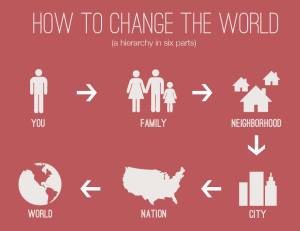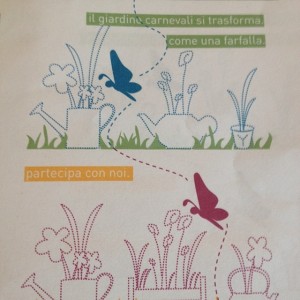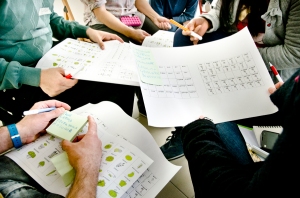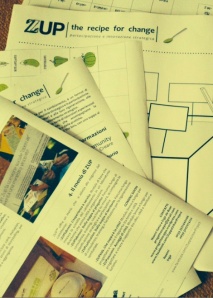Writing the recipe of your ideal house
agosto 26, 2014
You’ve probably returned from your holidays and decided that something has to change. Whether it is the amount of time you dedicate to your friends or the relation between you and your neighbours. Because even though you probably haven’t chosen the people that live next door, you have to coop with this anyways. So you better make the best out of it.
ZUP once started with the aim to get people together. And even though we now are ZUP The Recipe for Change, one of our goals is still to tighten relationships in order to join forces as 1+1 could quiet easily become 3. Even in situations where you won’t expect it.
In Europe there are different types of ‘mass-housing’ also known as apartment blocks. In the north usually these are built in post-war modern architecture styles. The buildings are anonymous and, besides a few exceptions, there is not much space for interaction between the inhabitants. That’s why soon these buildings became unpopular and a source of (social) problems.
Going more south, where the climate is warmer and the people are used to live ‘outdoors’ there usually is also more space to encounter the neighbours, take some minutes for some small talk or sit and watch the children play. But also here people start to complain that people live on their own and ‘no one knows its neighbour’.
If there is a will, a way can be found. There already exist lots of examples of co-housing projects in which future inhabitants organize events to get to know each other even before they start building, to find out their needs and their demands and bring these together to enable to construct an ‘ideal situation to live in’.
However, building from scratch is not a necessity if you want to create a community. Also in existing situations it is possible to make a change and create better relations between you and your neighbors. And that is where ZUP The Recipe for Change comes in. As no other we know how to involve inhabitants and – in one or more workshops that are as well entertaining as ‘educating’ – we find out the current situation and look for ‘solutions’ for the future. All done in collaboration with the inhabitants to start to shape a community and make sure that all get involved and understand the why of the project.
Did you escape from the everyday life inspire you to make a positive change? Than come to the first edition of Experiment Days Milan on the 11th and 12th of October and get more info on how ZUP can be useful in your situation.
ZUPlabmini and via Cenni: Cultivating transformation
agosto 5, 2014
What is a vegetable garden for me? With what values do I want to feed myself? Which wishes do I want to plant/seed? These are some of the questions that have articulated the steps of the ZUPlabmini workshop in Via Cenni, a social housing project in the West of Milan. The goal of this workshop was to work, together with a motivated group of inhabitants, on the design and realisation of the vegetable garden that will be used to share and collaborate.
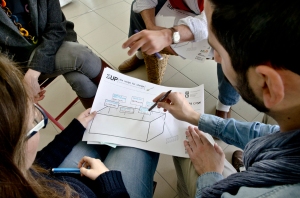
ZUP The Recipe for Change has proposed a workshop of co-design to elaborate the idea to create a shared garden on the terraces of their apartment building, The workshop was part of the project CenniColtiva! (the apartment is in Via Cenni, coltivare is the Italian word for cultivation) organised by Food in the Streets under the commission of Life 10 – ECO Courts (ECOlogical COurtyards United for Resources saving through smart Technologies and life Styleand supported by the Fondazione Housing Sociale.
On the last Saturday of March 2014, together with Inge (read her report here) we had only a few hours to execute a ZUPlabmini – the circumstances asked for a flexible approach from our side – in which the participants slowly discovered their personal report between their wishes and expectations related to the garden. In only a few hours the different groups defined a theme and found a name for the gardens on the four communal terraces of Via Cenni. Giving a name means finding the voices and the vocations of a place, for a garden like this one, shared by a coloured community, multi-generations and participative. Implicitly with a name one discusses the future, the continuity of a curated action and ZUP has also worked on this: from how to appropriate a space to the development of the project itself.
We collected words, ideas, desires. About twenty participants on a sunny Saturday morning have shared their expectations on the garden project. They put down a list of wishes, images and later flavours, smells colours, herbs and flowers. From the ingredients of their project, the final sum of their imagination plus concrete earth, we have defined a list of ingredients, to create a recipe that is and also explains the project.
The four recipes of Via Cenni are the soup of the Mediterranean, Zupapo’, Astrozuppa and Brave flavours in Rime.
The four shared gardens have different names and different stories. A recall to the Mediterranean to follow a list of aromatic herbs, or to the effervescence and sympathy of the group of woman (the patatasgirls) that look forward to cultivate peppers and poetry. There were groups that have taken an image as starting point, others a memory. That is how one group ended-up with a soup called Bahay – Kubo, which in Philippian means House between the vegetable gardens. Last but not least the Garden under the stars (Orto sotto le Stelle or Garden under the Stars) inspired by a colourful flowers called astronano.
For those who like to read the recipes we suggest you to download them here Assaggi di Via Cenni_Il ricettario di ZUP” (in Italian).
For this beautiful experience, a new direction for ZUP The Recipe for Change, we thank all the enthusiastic participants that not only designed bu will also take care of the gardens, and Food in the Streets, Life ECO Courts – Cortili ecologici and Fondazione Housing Sociale, for their assistance, the guidance, the coordination and their support.
Ps. Two weeks after the ZUPlabmini, the participants got a technical lecture by Orti d’Azienda to learn them how to take care of their garden, and of course they planted their first real seeds. If you are curious to read what happened there, we suggest to follow the link that brings you to the blog in which Food in the Streets gives you a report.
ZUP in numbers: reflections on the processes (and the challenges). Start a participation process
giugno 25, 2014
During the recent years, ZUP has elaborated a specific methodological canvas. The long experience on the territory of Noemi Satta and collaboration between different groups allows us to give you some numbers and dimensions that demonstrate the impact of the ZUPlab. Ready? Here we go!
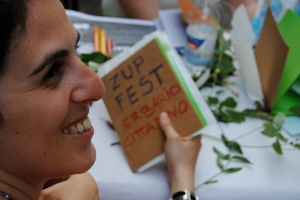
For those who don’t know: ZUP was founded in 2011 as an experiment of a long, including, shared, multi-disciplinal and multi-sectorial process in the Dergano/Bovisa area in Milan, Italy. It is a project that doesn’t fit easy in a specific sector but rather ‘floats’ somewhere between culture, urban or communal gardening, social and commercial projects: in the past years it is exactly this mix of interest that has demonstrated to have a strong possibility to activate energy hidden in neighbourhoods, organizations, businesses, etc.
In this blog we will present you some figures that will give you a dimension of the impact of a ZUPlab on the middle and long term.
In the year after the foundation of ZUP, between March and May 2011, we had twelve volunteers that helped us to organize the ZUPfest. Another 15 realities – amongst others institutes, associations and commercial activities – were involved to make this party with 150 guests all living in the neighbourhood possible. A simple Saturday afternoon became a happy event in the public domain: with the use of a kitchen, creative input and the activation of networks we activated the guests to create ideas and later form groups that took care of them with the end goal to realize them. On top off the people involved in person, this was followed by 15.000 people on the social networks and another 500.000 people that read articles about the event in national newspapers.
The value of the activities executed in 2011 (ZUPfest, ZUPranzo and ZUPlabmini) was covered by investments, gifts, volunteers and (technical) sponsoring from the network of f-autori culturali, local commercial activities and institutes.
The numbers you find above might not be shocking to you, but meaningful if you see it in the context of a small neighbourhood where the individual until then seemed to be more important than the collective. This ‘fest’ enabled us to involve parties like local commercial activities or the restaurant owners. Some of them even opened on this Saturday of ZUPfest, to offer the participants one of the soups from the ZUPfest menu.
Yes. A ZUP can do this!
Giardini Extravaganti al Giardino carnevali (a cura di Cap VentiCento) è uno dei modi che ZUP ha messo in atto per dare vita e costantemente seminare nel quartiere e nel Giardino Carnevali. La ricetta è semplice in apparenza: buoni progetti, eventi significativi, un programma di rilievo entro il quale essere inseriti, costante cura della partecipazione (coi suoi alti e bassi).
Il 7 giugno eravamo dentro Viadolcevia (a cura di Mamusca/Opella/Terradelfuoco e la partecipazione di innumerevoli partner) e il 15 marzo dentro il Sabato della Bovisa (del Politecnico con di nuovo una rete di partner numerosa): in entrambi i casi si è trattato di un’esperienza incredibile, per successo di pubblico, per qualità dell’esperienza, per capacità delle persone che gravitano intorno al giardino e per la rete di partner di #trasformare visioni e spazi.
Ps: guardate le foto e la coda lunga di pubblicazione e di commenti di viadolcevia . È stato un momento incredibile, che fa capire che la strada di condividere e creare insieme, la stessa intrapresa da ZUP e dal Giardino Carnevali in questi anni, può dare importanti risultati. Si tratta di credere nella collaborazione, nell’autoproduzione, nei tempi lunghi, nei piccoli numeri che generano un ritorno incredibile, con fiducia, entusiasmo e voglia di fare, di vivere, di #trasformare.
Ancora altri numeri: nel piccolo Giardino Carnevali (giardino discarica a Milano, zona Dergano-Bovisa) nel marzo 2012 inizia un lavoro di cura con un concerto di percussionisti. Circa 150 persone scendono dai palazzi, stupiti, sconvolti, curiosi, perplessi. È il non pubblico di questo genere di eventi, che nel quartiere normalmente richiama un target medio –alto, colto, progressista.
Ancora riportiamo i numeri rilevati per descrivere gli output e in parte gli outcome di una sola attività, come quella del Giardino Carnevali. Tra questi si considera per brevità solo il periodo 11/2012-11/2013: 8 eventi della partecipazione; attività di organizzazione e segreteria; coordinamento rete volontari. Le persone coinvolte sono state circa 600, con una buona comunicazione sui social e su stampa tradizionale (1.500 social a 600.000 stampa) e un primo allargamento della rete degli interessati. I primi effetti sono stati i seguenti: 10 volontari attivi; 4 negozianti intorno al giardino partecipi e coadiuvanti il processo (che si sommano ai 15 precedentemente attivati e partner tecnici della prima fase di ZUP2011), accompagnamento del CDZ 9, rete commercianti di via Tartini ulteriormente coinvolta e informata, network con associazioni e comitati dello stesso e di altri quartieri. L’obiettivo non è di mettere sotto tutela lo spazio e le persone, ma di generare possibilità e di alimentare progressivamente l’interesse, la partecipazione, le soluzioni di trasformazione.
In questo momento il gruppo di 10 volontari e il network ha già generato nuove attività e presto avrà un’immagine autonoma da ZUP (realizzazione del brand e dell’immagine coordinata del Giardino Carnevali grazie alla collaborazione con Annalinda de Rosa, designer del Politecnico) in un percorso verso l’autonomia che si ritiene importante come effetto del lavoro di ZUP.
E ancora non vi abbiamo raccontato del periodo 2013-2014!! #staytuned #Tobecontinued #zupinprogress #inumeriraccontano
I numeri di ZUP: riflessioni sui processi (e sulle sfide). Avviare il percorso di partecipazione.
giugno 14, 2014
ZUP ha permesso di elaborare un canovaccio metodologico specifico, e la lunga esperienza sul territorio e tra gruppi diversi permette di dare qualche numero e dimensione legata all’impatto.
ZUP nasce nel 2011 per sperimentare nel quartiere Dergano/Bovisa (Milano) un processo lungo, coinvolgente, aggregante, multidisciplinare e multisettoriale. È un progetto che non si incasella facilmente nel settore cultura, o in quello dei giardini, del commercio, o del sociale: di fatto ha una valenza forte di attivatore di energie, nelle sue diverse attività sviluppate nel quartiere.
Ecco alcuni dati per dare una dimensione dell’impatto di ZUP nel medio/lungo periodo.
Nel periodo 2011, anno di attivazione di ZUP: marzo-maggio 2011, 12 volontari per la ZUPfest, 15 realtà tra istituzioni, associazioni, esercizi commerciali, 150 partecipanti nel quartiere: non solo convivialità, ma ricerca, riconoscimento e riappropriazione dello spazio pubblico attraverso la cucina e la creatività, attivazione di reti, attivazione di idee e di gruppi che le portino avanti. Oltre 15.000 nei social network, circa 500.000 lettori su stampa nazionale.
Il valore delle attività svolte nel 2011 (ZUPfest, ZUPranzo, ZUPlab) è coperto da investimenti, elargizioni liberali, volontariato, sponsorship tecniche e dalla rete di f-autori culturali, commerciali e istituzionali.
Sono numeri non eclatanti di per sé ma significativi rispetto a un quartiere e ad alcuni soggetti, come i commercianti o i ristoratori, difficili da coinvolgere: questi ultimi hanno appositamente aperto di sabato per realizzare la maratona di zuppe della ZUPfest.
#zupinprogress #tobecontinued
Cambiamento al centro. Anche ZUP al festival delle comunità del cambiamento. Alla ricerca di sguardi lunghi.
giugno 13, 2014
Comunità e organizzazioni in cambiamento: questa è la parola chiave anche per il festival organizzato da Rena a Bologna. Un incontro cui abbiamo deciso di aderire immediatamente, convinte come siamo che la cooperazione e la condivisione siano la chiave di successo di tutti i percorsi di trasformazione.
Seminiamo partecipazione e trasformazione da anni con ZUP, che a sua volta si avvale dell’esperienza più che decennale dei fondatori, e questo è il momento in cui il confronto con tutte le organizzazione che basano il loro lavoro sul cambiamento è necessario.
Più di 350 aderenti tra diverse realtà, diversi tavoli di lavoro dalla governance dei beni comuni, alla promozione del patrimonio culturale, alla filiera di innovazione sociale che nasce nell’ambito rurale, al tema dell’attivazione delle comunità, dal punto di vista degli attivatori e organizzatori di processi lunghi.
Ci aspettiamo sguardi lunghi.
PS: e il buon segno si è visto da subito: servizi di baby sitting e laboratori di coderdojo per i più grandetti, primo servizio messo in evidenza per le mamme e i papà che parteciperanno ai lavori.
La qualità di questi incontri (come nella vita) inizia da questi “dettagli”! #cambiamento #trasformazione #zupinprogress
Volete saperne di più? Scarica la brochure di ZUP The Recipe for Change
ZUPlab goes Bologna
Maggio 29, 2014
Is it possible to immagine another scenario than the one we thought we were going to follow?
This was the main questions with which we started a critical trip curated by Raffaele Quattrone which has given shape to the //:(TT)+U=Think The Unthinkable exhibition that is, on the moment we have our ZUPlab, on display in the Galleria OltreDimore in the Italian city of Bologna.
ZUP is selected by the collective and brought its ZUPlab for the first time to Bologna on the 23th of May 2013.
What did we do?
The participants of the ZUPlab have ‘read’ the city therefore using its communal sites and looking for new points of view, surprises and unexpected novelties. As a final step of the workshop these observations were translated in recipes to cook and taste together the soups of Bologna. Like every ZUPlab also this one was custom made for the specific situation.
Recipes named ‘ The studied, the fat and the pink’, could sound like something absurd, but the recipes are there and they are beautiful and tasteful.
Within a few weeks ZUP returns to Bologna to participate to the Festival delle Communità del Cambiamento, organized by Progetto Rena (which translates in The Festival of Comunities of Change). We will keep you updated on that!
ZUPlabmini e via Cenni: coltivare trasformazione
aprile 11, 2014
Cos’è un orto per me? Di quali valori voglio nutrimi? Quali desideri voglio seminare? Queste sono alcune delle domande che hanno scandito le tappe del laboratorio ZUPlabmini finalizzato a far lavorare sul progetto dell’orto un gruppo di abitanti di cohousing motivato e abituato alla condivisione.
Per questo ZUP The recipe for change ha proposto un laboratorio di progettazione partecipata dell’orto condiviso condominiale, inserito all’interno del Progetto Cennicoltiva! di Food in the Streets, per Life 10 – ECO Courts (ECOlogical COurtyards United for Resources saving through smart Technologies and life Style), e per l’innovativa esperienza di cohousing di Via Cenni improntata alla condivisione e al risparmio energetico e seguita da due anni dalla Fondazione Housing Sociale.
Il 29 Marzo, insieme a Inge (lei ne parla qui), sapevamo di dover concentrare ZUPlabmini, dal canovaccio flessibile e adattabile, in poco tempo sul progetto e sul rapporto tra desiderata/aspettative legate all’orto, per arrivare in modo semplice a dare un nome a ciascuna delle terrazze. Dare un nome vuole dire trovare la voce e le vocazioni di un luogo, per un orto come questo, condiviso da una comunità colorata, multigenerazionale e partecipativa. Implicitamente con un nome si discute di futuro, della continuità di un’azione di cura e ZUPlab anche su questo ha lavorato: sull’appropriarsi di uno spazio, fin dal progetto.
Abbiamo raccolto parole, idee, desideri. Una ventina di partecipanti in una mattinata di sole hanno condiviso le loro aspettative sul progetto dell’orto, hanno messo in fila una lista di desiderata, immagini, e poi sapori, odori, spezie, fiori. Dagli ingredienti del loro progetto, summa di immaginario e di terrestre concretezza, abbiamo definito la lista di ingredienti, per creare una ricetta che è anche in questo caso racconto e progetto.
La vellutata di mediterraneo, o Arditi sapori in rima o ancora Zupapo’, e infine Astrozuppa sono le 4 ricette di via Cenni.
I 4 orti condivisi hanno nomi diversi, e storie diverse. Uno richiama al mediterraneo (profumo di mediterraneo) per seguire la propria lista di aromi, o all’effervescenza e simpatia delle ortiste (the patata’s girls) tra peperoncino e poesia. C’è chi si è affidato ad un’immagine, un ricordo, e alla stessa realtà di via Cenni con le parole “bahay-kubo” che in filippino significa “casa tra gli orti”. L’orto infine è “sotto le stelle” per chi ha scelto l’essenza guida dell’astrolabio.
Ecco allora il ricettario “Assaggi di Via Cenni_Il ricettario di ZUP” (e di ricette magari ne nasceranno altre!). Per questa esperienza, nuovo tassello di ZUP the recipe for change, ringraziamo chi ha partecipato e curerà questi promettenti orti, gli abitanti di via Cenni, e Food in the Streets, Life ECO Courts – Cortili ecologici e FondazioneHousingSociale, per l’assistenza, la guida, il coordinamento, il supporto concreto e progettuale.
Ps: il 12 aprile il secondo appuntamento di Cennicoltiva! Food in the streets lavora con Orti d’azienda per proseguire tecnicamente sul progetto dell’orto. Buon lavoro!
È ora di uscire allo scoperto. È da circa 6 mesi che stiamo pensando a come mettere in evidenza una serie di esperienze che ZUP ha fatto in diversi territori e in diversi contesti anche extra territoriali.
ZUP ha all’attivo casi e strumenti per raccontare i territori, ma anche per descrivere e immaginare le trasformazioni che si desiderano. ZUP è riuscito a raccontare, ma anche a mappare, a far degustare, a far guardare di nuovo (ri-guardare) e con nuovi occhi, e a far prendere in cura. Un progetto di rigenerazione urbana, tra cibo creatività partecipazione. Solo a Dergano Bovisa? No (anche se è una delle esperienze più lunghe e con le maggiori sfaccettature), anche in: Porta Romana, Lambrate, Sarpi. E poi a Bologna, e poi in fiera (Fa la cosa giusta), e poi con performer teatrali, o per creativi, per studenti, per gli innovatori sociali, per i cittadini di un quartiere o per abitanti di un nuovo spazio di cohousing. Per grandi e per bambini, per esperti o per neofiti.
Inoltre con approcci strategici, di management e di gestione dei gruppi sempre diversi, in casi più leggeri e ludici e in altri di conflittualità o di fatica del territorio, in mezzo alla spazzatura o tra gli stand di una fiera o in galleria d’arte.
Queste esperienze ci hanno insegnato che ZUP funziona e può davvero attivare il cambiamento. Ecco perché dall’esperienza di ZUP Zuppa Urban Project nasce ZUP The recipe for change. Partecipazione e innovazione strategica.
Ci interessa innescare la scintilla della partecipazione e dell’innovazione strategica, come prima, per territori e più chiaramente per imprese. ZUP percorre la strada intrapresa da molto tempo (nella attività professionale dei singoli componenti del team) di portare tecniche creative, strategiche e di facilitazione, tramite workshop di innovazione strategica, all’interno di imprese, fondazioni, consorzi, cooperative.
Il binomio territorio e cibo inoltre è uno dei terreni comuni con Inge de Boer, di Food in the streets, parte del team più stretto con cui si è definita ed è partita la nuova stagione di ZUP (e qui un assaggio di una delle azioni già frutto della nostra collaborazione come ZUP The recipe for change). Il team è in via di allargamento in questi mesi, presto nuovi aggiornamenti.
Nel frattempo anche questo blog e tutta l’immagine di ZUP cambierà nelle prossime settimane: per ora nuove pagine, nuovi contenuti per seguire le novità che stiamo preparando. Seguiteci anche con #zuptherecipeforchange su fb e tw.
